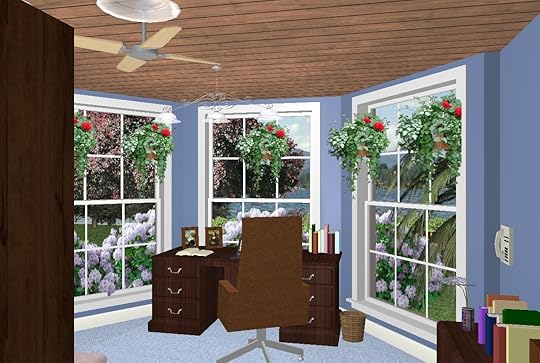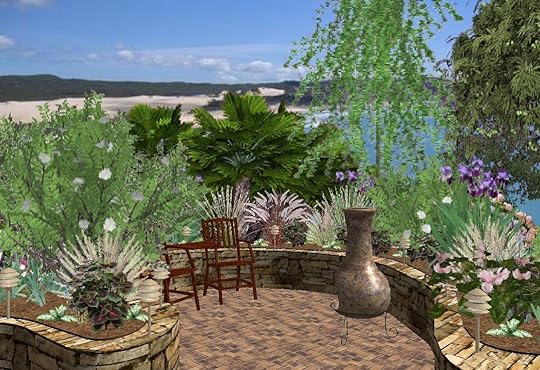Live Where You Don’t Exist
 As writers we spend a lot of time in worlds that don’t exist. If you are trying to write about a lifestyle which is outside your experience, it can be hard to get the details right. Or if you are a writer who prefers to focus more on plot and character development than people and place descriptions, coming up with outfits, physical appearances, landscapes etc. can be annoying! However, the best writing engages all the five senses in a reader: what places and people look like; what smells are dominant and move the story forward; textures such as fabric or furniture (touch); the taste of food and sounds which are relevant to the storyline.
As writers we spend a lot of time in worlds that don’t exist. If you are trying to write about a lifestyle which is outside your experience, it can be hard to get the details right. Or if you are a writer who prefers to focus more on plot and character development than people and place descriptions, coming up with outfits, physical appearances, landscapes etc. can be annoying! However, the best writing engages all the five senses in a reader: what places and people look like; what smells are dominant and move the story forward; textures such as fabric or furniture (touch); the taste of food and sounds which are relevant to the storyline.
You may find it helpful to treat your writing like a movie set. Consider what features, objects and looks will harmonise with what you need to communicate about the character’s personality, state of mind, living or working space, economic lifestyle or neighbourhood.
 To do that you have several options.
To do that you have several options.
You can research. Make sure you have your facts straight, particularly if you are writing about a different time period or country. Don’t just look at the words though, look at as many photos and illustrations as you can. Check historical almanacs, coffee table books and anything you can get your hands on from other periods in time to get hold of details.
Start a file for each book or character, particularly if you are having issues getting it all straight in your head! It doesn’t have to be big.
Sketch out the floor plans of offices, workplaces, homes, restaurants where key events happen etc.
Go somewhere and take notes about the decor and furnishings. In an awkward silence in a meal you can have a character notice that flaking paint in a fancy restaurant. Stories you can picture are always the best!
Read through house and garden magazines and find ideal home styles, rooms and gardens which you can use or adapt.
Build a file of fashion magazines including various budgets. Also use them for describing character’s facial features, hairstyles and other aspects of physical appearance. Magazines which feature real people’s stories and photos are ideal for this, as they remove the photoshopped false perfection. When I wrote the Chronicles of Mirchar, I had a picture of every character taken from a magazine so I could build in variety and individualism.
Sketching out details such as these can also save you editing work later. For example, it helps in picking up inconsistencies, such as the fact that the poison hidden in the cupboard above the fridge, is suddenly hidden next to the dishwasher two chapters later… Oops! A quick kitchen plan can help you iron out what is where, plot how events happen and give you that gem every writer needs… even more ideas. If they trip over the mat… then land next to the glass cabinet… then they will see that half-hidden photo which causes all hell to break loose!
If you can picture it, you will know how to write it!

This article is Copyright Cate Russell-Cole 2012. It may not be reproduced in any form, without my prior written permission. All rights reserved. Images from this post were built using Chief Architect’s Home Design Software eons ago and may be reproduced without breaking copyright.
 If you are interested in adding more depth to your writing, you may find Creating and Resolving Conflicts In Fiction helpful. This book dissects conflict into it’s component parts; looks at how it works and helps you generate conflict plot-lines and themes which will add richness and realism to your work. The principles apply to any kind of fiction, regardless of the length, characters or genre. It is written by a writing teacher who also has a background in counselling.
If you are interested in adding more depth to your writing, you may find Creating and Resolving Conflicts In Fiction helpful. This book dissects conflict into it’s component parts; looks at how it works and helps you generate conflict plot-lines and themes which will add richness and realism to your work. The principles apply to any kind of fiction, regardless of the length, characters or genre. It is written by a writing teacher who also has a background in counselling.
Creating and Resolving Conflict in Fiction is the first book in the Four Dimensional Characterisation Series. The series has been written to give writers an insight into the aspects of psychology that are the most invaluable for fiction writers. It will assist you in creating personality traits and behaviour patterns which make your characters realistic, unique and believable. This book in the series is focussed on conflict in any kind of relationship.
Filed under: Creativity, Fiction and Characterisation, Food For Thought, Indie Publishing, Writing Tagged: author, books, challenge, characterisation, creativity, description, details, fiction, five senses, ideas, inspiration, originality, research, set, setting, stage set, success, writer, writing





